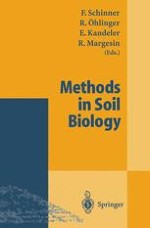1996 | OriginalPaper | Chapter
Bacterial Biomass
Authors : G. Trolldenier, M. Schholter, W. Bode, A. Hartmann
Published in: Methods in Soil Biology
Publisher: Springer Berlin Heidelberg
Included in: Professional Book Archive
Activate our intelligent search to find suitable subject content or patents.
Select sections of text to find matching patents with Artificial Intelligence. powered by
Select sections of text to find additional relevant content using AI-assisted search. powered by
Among soil microorganisms, bacteria are particularly suitable for quantification by counting. It should be considered, however, that bacteria are never uniformly distributed in the soil and that their spatial arrangement varies even in neighbouring microsites. Furthermore, the bacterial biomass may fluctuate drastically within short periods. Counting of soil bacteria can be achieved by direct microscopy as well as by cultural methods. The most widespread cultural method, the plate count technique, is based on the development of colonies from individual propagules. Microscopic bacteria counts of soil samples are often up to 1000 times greater than viable counts obtained by cultural techniques. The reasons for the greater values obtained by microscopy are the inclusion of dead cells and organisms which fail to grow in conventional culture media under the conditions of incubation provided. Groups of bacteria generally not included in viable counts are e.g. nitrogen-fixing bacteria, nitrifiers, cellulolytic organisms and anaerobic bacteria, as they depend on selective media and/or special growth conditions.
